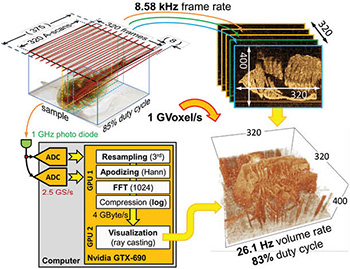 Scanning protocol for 1 GVoxel/s 4-D real-time OCT system.
Scanning protocol for 1 GVoxel/s 4-D real-time OCT system.
Optical coherence tomography (OCT) is a depth-resolved imaging modality that provides micrometer-scale cross-sectional and 3-D information on the scattering properties of biological samples.1 Video rate real-time 3-D volumetric OCT (4-D-OCT) could generate a new class of optical tools in clinical practice, like surgical guidance.2 This challenge requires us to combine a high-speed OCT imaging setup, ultrafast data acquisition and adequate real-time data processing to process and visualize the vast amount of data.
Although 4-D-OCT has long been a dream for researchers, only a few groups have successfully implemented 4-D volumetric OCT imaging with real-time visualization—usually with low resolution, and sometimes with a massive amount of dedicated hardware that prohibits widespread use.3,4 In 2014, we presented a major advance: a real-time 4-D swept-source OCT system featuring more than 1 GVoxel/s—nearly an order of magnitude faster than previous systems (approximately 125 MVoxels/s).4,5 With a volume size of 320 × 320 × 400 and a flicker-free 3-D volume rate of 25 Hz, this system represents a breakthrough in real-time OCT. Notably, a resolution that had previously been in the realm only of smooth 2-D imaging is now available for smooth 3-D volumetric imaging.
The system applies a Fourier-domain mode-locking (FDML) laser with a sweep rate of 3.2 MHz.6 All computations are performed on a single, consumer-grade GPU card in a standard desktop computer equipped with two high-speed (2.5 GS/s) PCIe digitizer cards. Dedicated electronics trigger these cards in volume interleave mode and synchronize the FDML laser with the resonant galvo scanners. Self-developed multithreaded software reassembles the OCT data and transfers a stream of about 2 GBytes/s to the GPU card, which performs all OCT computations as well as high-quality 3-D visualization via ray casting.
The system’s high speed makes it useful for capturing and understanding fast dynamics. The volume acquisition rate can be doubled to 50 Hz by reducing the volume size (320 × 160 × 400), which enables “slow-motion OCT” playback and allows the study of these dynamics.
The 4-D-OCT presented here has the potential to create new applications for OCT, like the study of fluid dynamics or capturing 3-D movements and morphology. It will allow new insights through fast, high-quality, depth-resolved imaging modalities.
Researchers
Wolfgang Wieser, Wolfgang Draxinger, Thomas Klein, Sebastian Karpf and Tom Pfeiffer, Ludwig-Maximilians-Universität München (LMU), and Optores GmbH, Germany
Robert Huber, LMU, Universität zu Lübeck, and Optores GmbH, Germany
References
1. D. Huang et al. Science 254, 1178 (1991).
2. Y.K.K. Tao et al. Opt. Lett. 35, 3315 (2010).
3. M. Laubscher et al. Opt. Express 10, 429 (2002).
4. D.-H. Choi et al. Biomed. Opt. Express 3, 3067 (2012).
5. W. Wieser et al. Biomed. Opt. Express 5, 2963 (2014).
6. R. Huber et al. Opt. Express 14, 3225 (2006).
